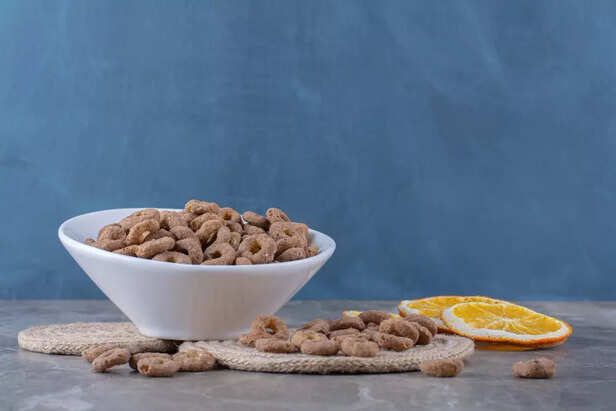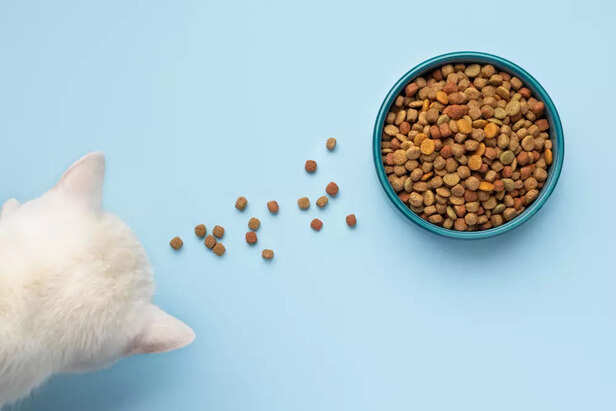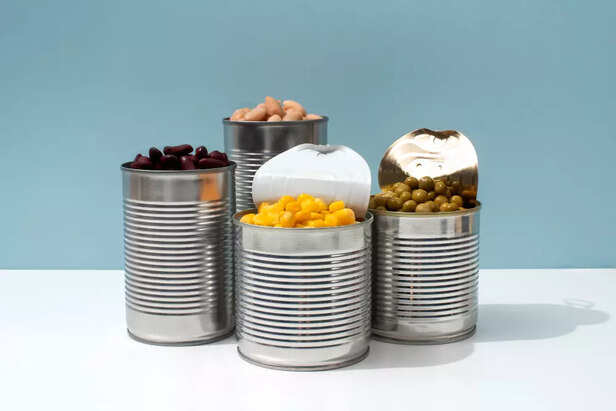Is Canned or Dry Food Better for Your Cat's Health
Ashna Khare | May 13, 2025, 06:30 IST
( Image credit : Freepik )
When deciding what’s best for your cat, the choice between canned and dry food often leaves pet owners confused. Canned food offers more hydration and fewer fillers, making it a good option for cats with specific health concerns, like urinary issues. On the other hand, dry food is easy to store, helps with dental care, and is cost-effective. This article breaks down the pros and cons of both, guiding you to make the best food choice for your cat's health and lifestyle.
As a pet owner, choosing the right food for your cat can be overwhelming, especially when faced with the decision of canned versus dry food. Both have their advantages and disadvantages, and understanding the differences is key to making the best choice for your furry friend’s health. In this article, we will explore both options, their benefits, and potential drawbacks, so you can make a well-informed decision.
Cats, being obligate carnivores, rely heavily on protein from animal sources for their nutrition. A proper diet will not only keep your cat healthy but also contribute to their happiness. So, when faced with the decision of feeding your cat canned food or dry kibble, it’s important to consider various factors such as their health, lifestyle, and preferences.

Canned food, often referred to as wet food, is typically made with higher moisture content, which is one of its most significant benefits. Cats tend to have a low thirst drive, meaning they don’t drink enough water on their own. The moisture in canned food helps ensure that they stay hydrated, which is essential for their overall health. This is particularly beneficial for cats that have urinary tract issues or kidney problems, as they need to maintain hydration levels.
Another major advantage of canned food is that it usually contains fewer carbohydrates compared to dry food. Cats are not able to digest carbohydrates as efficiently as they do protein. High-carb diets can lead to weight gain and other health issues like obesity and diabetes. Canned food is typically protein-rich, offering a more balanced and natural diet for your cat.
Canned food is also easier for senior cats or cats with dental problems to chew. Since the food is soft, it’s gentler on their teeth and gums, allowing them to enjoy their meals without much difficulty.
While canned food has several benefits, it does come with its own set of challenges. One of the biggest drawbacks is the cost. Canned food tends to be more expensive than dry food, especially if you’re feeding your cat regularly. If you have multiple cats or are on a tight budget, it can be difficult to maintain a consistent canned food diet.
Additionally, canned food requires more storage space. It comes in cans or pouches, which must be kept in your pantry or fridge. If your cat doesn’t finish a can in one sitting, it needs to be stored properly and eaten within a few days, which may lead to waste if your cat is a picky eater.
Canned food does not provide the same dental benefits as dry food. While some canned foods contain ingredients that help with oral health, they cannot effectively scrape plaque from your cat’s teeth the way dry kibble can.

Dry food, also known as kibble, is another popular option for feeding cats. One of its main advantages is convenience. Dry food is easy to store, and it doesn’t spoil as quickly as canned food. You can leave it out for longer periods, making it an ideal choice for busy pet owners or those who are not home throughout the day.
Dry food is also more affordable than canned food. If you’re looking for an economical choice that will last a long time, dry kibble is often the best option. It is available in larger bags, and feeding it regularly is much more cost-effective, especially for those who have multiple cats.
Another benefit of dry food is its potential for promoting dental health. The crunchy texture of dry kibble can help reduce plaque and tartar buildup on your cat’s teeth, which may help prevent dental issues. While it’s not a replacement for regular brushing, dry food can be a helpful part of your cat’s oral care routine.
Despite its advantages, dry food has some potential downsides as well. One of the biggest concerns with dry food is its low moisture content. Cats that eat primarily dry food may not get enough hydration, which can lead to dehydration and other health issues like kidney disease and urinary tract infections. This is why it’s crucial for cats on a dry food diet to drink plenty of water.
Dry food also tends to have higher carbohydrate levels than canned food. Since cats are obligate carnivores, they don’t require carbohydrates in their diet. Excessive carbs can contribute to weight gain, obesity, and other metabolic issues. When choosing dry food, it’s essential to select a high-quality product that prioritizes animal protein and limits fillers.
While dry food can help with dental health, it’s not a complete solution. Some cats may not chew their food thoroughly, and kibble alone is not enough to prevent all dental problems. Regular vet checkups and professional cleanings may still be necessary for maintaining good oral health.

The choice between canned and dry food ultimately depends on your cat’s unique needs, health, and preferences. If your cat is prone to urinary tract issues, kidney disease, or simply doesn't drink enough water, canned food may be the better option because of its higher moisture content. It’s also ideal for older cats or those with dental problems who need softer food to chew.
On the other hand, dry food offers convenience, affordability, and dental benefits. If you are looking for an easy-to-store food option or a cost-effective solution, dry food might be a better fit for your cat’s lifestyle. However, make sure your cat is drinking enough water if you choose dry food.
Many cat owners choose to feed their pets a combination of both canned and dry food. This approach allows you to balance the hydration benefits of canned food with the convenience and dental benefits of dry food. Mixing the two types of food can ensure that your cat’s nutritional needs are met while keeping their meals interesting and varied.
Choosing the right food for your cat requires careful consideration of their health needs, lifestyle, and personal preferences. Both canned and dry food have their advantages and disadvantages, so it’s important to weigh the pros and cons before making a decision. By understanding the unique benefits of each, you can make an informed choice that will help your cat thrive. Always consult your vet to ensure that the food you provide is best suited to your cat’s individual health requirements. With the right diet, your cat will enjoy a long, healthy, and happy life.
Discover expert advice and the latest tips on pet care, training, health, and more. Stay updated with all things pets at Times Pets!
Cats, being obligate carnivores, rely heavily on protein from animal sources for their nutrition. A proper diet will not only keep your cat healthy but also contribute to their happiness. So, when faced with the decision of feeding your cat canned food or dry kibble, it’s important to consider various factors such as their health, lifestyle, and preferences.
Canned Food for Cats : A Closer Look

Canned Food for Cats: A Closer Look
( Image credit : Freepik )
Canned food, often referred to as wet food, is typically made with higher moisture content, which is one of its most significant benefits. Cats tend to have a low thirst drive, meaning they don’t drink enough water on their own. The moisture in canned food helps ensure that they stay hydrated, which is essential for their overall health. This is particularly beneficial for cats that have urinary tract issues or kidney problems, as they need to maintain hydration levels.
Another major advantage of canned food is that it usually contains fewer carbohydrates compared to dry food. Cats are not able to digest carbohydrates as efficiently as they do protein. High-carb diets can lead to weight gain and other health issues like obesity and diabetes. Canned food is typically protein-rich, offering a more balanced and natural diet for your cat.
Canned food is also easier for senior cats or cats with dental problems to chew. Since the food is soft, it’s gentler on their teeth and gums, allowing them to enjoy their meals without much difficulty.
The Drawbacks of Canned Food
Additionally, canned food requires more storage space. It comes in cans or pouches, which must be kept in your pantry or fridge. If your cat doesn’t finish a can in one sitting, it needs to be stored properly and eaten within a few days, which may lead to waste if your cat is a picky eater.
Canned food does not provide the same dental benefits as dry food. While some canned foods contain ingredients that help with oral health, they cannot effectively scrape plaque from your cat’s teeth the way dry kibble can.
Dry Food for Cats : The Benefits

Dry Food for Cats: The Benefits
( Image credit : Freepik )
Dry food, also known as kibble, is another popular option for feeding cats. One of its main advantages is convenience. Dry food is easy to store, and it doesn’t spoil as quickly as canned food. You can leave it out for longer periods, making it an ideal choice for busy pet owners or those who are not home throughout the day.
Dry food is also more affordable than canned food. If you’re looking for an economical choice that will last a long time, dry kibble is often the best option. It is available in larger bags, and feeding it regularly is much more cost-effective, especially for those who have multiple cats.
Another benefit of dry food is its potential for promoting dental health. The crunchy texture of dry kibble can help reduce plaque and tartar buildup on your cat’s teeth, which may help prevent dental issues. While it’s not a replacement for regular brushing, dry food can be a helpful part of your cat’s oral care routine.
The Drawbacks of Dry Food
Dry food also tends to have higher carbohydrate levels than canned food. Since cats are obligate carnivores, they don’t require carbohydrates in their diet. Excessive carbs can contribute to weight gain, obesity, and other metabolic issues. When choosing dry food, it’s essential to select a high-quality product that prioritizes animal protein and limits fillers.
While dry food can help with dental health, it’s not a complete solution. Some cats may not chew their food thoroughly, and kibble alone is not enough to prevent all dental problems. Regular vet checkups and professional cleanings may still be necessary for maintaining good oral health.
Which Is Better for Your Cat: Canned or Dry Food?

Canned Food?
( Image credit : Freepik )
The choice between canned and dry food ultimately depends on your cat’s unique needs, health, and preferences. If your cat is prone to urinary tract issues, kidney disease, or simply doesn't drink enough water, canned food may be the better option because of its higher moisture content. It’s also ideal for older cats or those with dental problems who need softer food to chew.
On the other hand, dry food offers convenience, affordability, and dental benefits. If you are looking for an easy-to-store food option or a cost-effective solution, dry food might be a better fit for your cat’s lifestyle. However, make sure your cat is drinking enough water if you choose dry food.
Many cat owners choose to feed their pets a combination of both canned and dry food. This approach allows you to balance the hydration benefits of canned food with the convenience and dental benefits of dry food. Mixing the two types of food can ensure that your cat’s nutritional needs are met while keeping their meals interesting and varied.
Choosing the right food for your cat requires careful consideration of their health needs, lifestyle, and personal preferences. Both canned and dry food have their advantages and disadvantages, so it’s important to weigh the pros and cons before making a decision. By understanding the unique benefits of each, you can make an informed choice that will help your cat thrive. Always consult your vet to ensure that the food you provide is best suited to your cat’s individual health requirements. With the right diet, your cat will enjoy a long, healthy, and happy life.
Discover expert advice and the latest tips on pet care, training, health, and more. Stay updated with all things pets at Times Pets!
Frequently Asked question (FAQ's)
- Is dry or canned food better for cats?Canned food is better for hydration, while dry food offers convenience and dental benefits—each has unique advantages.
- Do vets recommend dry or wet cat food?Most vets recommend a mix of both to balance hydration, nutrition, and dental care.
- What is the healthiest food to feed a cat?The healthiest food is high in animal protein, low in carbs, and meets your cat’s specific health needs.
